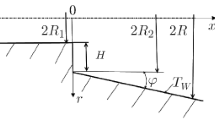Summary
Heat flux, wall heat transfer coefficients, and wall pressures are determined for high velocity flow of gas-solid mixtures in a converging-diverging nozzle. Flow separation accompanied with oblique shock formation occurs in the diverging section of the nozzle. The shock strength is reduced upon the addition of solid particles. The wall pressure in the convergent section of the nozzle appears unaffected by the presence of solid particles. In the divergent section, however, the wall pressure is slightly lowered. At the maximum ratio of solid to air flow used in the experiments (3.7) increases in the heat transfer rate of up to 20 and 50 percent are obtained in the convergent and separated (divergent) regions of the nozzle, respectively. Slightly larger increases in the wall heat transfer coefficients are also obtained. It is concluded that the wall heat flux and heat transfer coefficients are influenced strongly by the presence of disturbances upstream of the nozzle inlet.
Similar content being viewed by others
Abbreviations
- W a :
-
air flow rate
- W s :
-
solids flow rate
- x :
-
axial distance from nozzle entrance
- L :
-
axial length of nozzle
- γ :
-
specific heat ratio of fluid
- A e :
-
exit cross section of flow
- A * :
-
throat cross section of flow
- P 0 :
-
inlet pressure
- P s :
-
wall separation pressure
- P a :
-
ambient exhaust pressure
- β :
-
shock wave angle
- θ :
-
shock wave deflection angle
- M 1 :
-
Mach number upstream of shock wave
- \(M_{1_n } \) :
-
Mach number normal to shock wave
- q :
-
heat flux
- k f :
-
thermal conductivity of fluid
- T wi :
-
inside wall temperature
- T wo :
-
outside wall temperature
- T ad :
-
adiabatic wall temperature
- h :
-
wall heat transfer coefficient
- C :
-
nozzle constant
- A :
-
local cross section of flow
- c p :
-
specific heat of fluid
- Pr :
-
Prandtl number
- μ :
-
viscosity of fluid
- r c :
-
throat radius of curvature
- σ :
-
factor accounting for variation of ρ and μ
- absolute temperature °R(ankine):
-
°F+459.7
- conductivity 1 BTU (hr ft °F)−1 :
-
4.137×10−3 cal (s cm °C)−1
- specific heat 1 BTU (1b °F)−1 :
-
1 cal (g °C)−1
- absolute pressure 1 psia:
-
0.0680 atm
References
Gilbert, M., L. Davis, and D. Altman, ARS J. 25 (1955) 25.
Kliegel, J. R., One-Dimensional Flow of a Gas-Particle System, S.T.L. TR-59-0000-00746, 1959.
Kliegel, J. R. and G. R. Nickerson, Progr. in Astronautics and Rocketry, Vol. 6 p. 173, Ed. S. S. Penner and F. A. Williams, Academic Press, New York 1962.
Bailey, W. S., E. N. Nilson, R. A. Serra, and T. F. Zupnik, ARS J. 31 (1961) 793.
Hogland, R. F., ARS J. 32 (1962) 662.
Rannie, W. D., Progr. in Astronautics and Rocketry, Vol. 6 p. 117, Ed. S. S. Penner and F. A. Williams, Academic Press, New York 1962.
Marble, F. E., Dynamics of a Gas Containing Small Solid Particles, presented at the Fifth AGARD Combustion and Propulsion Colloquium, Braunschweig, April 1962.
Fortini, A. and R. C. Ehlers, NASA TN D1743, August 1963.
Back, L. H., P. F. Massier, and H. L. Gier, Int. J. Heat Mass Transfer 7 (1964) 549.
Back, L. H., P. F. Massier, and H. L. Gier, AIAA J. 3 (1965) 1606.
Sutton, G. P., Rocket Propulsion Elements, Wiley, New York 1949.
Zucrow, M. J., Aircraft and Missile Propulsion, Vol. 1, p. 366, Wiley, New York 1962.
Bloomer, H. E., R. J. Antl, and P. E. Renas, NASA TN D-846, June 1961.
Arens, M. and E. Spiegler, AIAA J. 1 (1963) 578.
Farley, J. M. and C. E. Campbell, NASA TN D-293, October 1960.
Kuethe, A. M. and J. D. Schetzer, Foundations of Aerodynamics, Wiley, New York 1959.
Sibulkin, M., J. Aero. Sci. 23 (1956) 162.
Bartz, D., ASME Trans. 77 (1955) 1235.
Seban, R. A. and D. Doughty, Heat transfer to laminar and turbulent boundary layers with constant and variable freestream velocity, University of California, Institute of Engineering Research, Series 41, No. 13, August 1954.
Baron, J. R. and F. H. Durgin, An experimental investigation of heat transfer at the boundaries of supersonic nozzles, Naval Supersonic Laboratory, Massachusetts Institute of Technology, WADC Technical Report 54–541 (1954).
Bartz, D., Jet Propulsion J. 27 (1957) 49.
Kolozsi, J. J., Masters thesis, Dept. of Aeronautics, Ohio State University (1958).
Author information
Authors and Affiliations
Additional information
Supported in part by aid provided by the UCLA Space Science Center (Grant NsG 236-62 Libby).
Listed for readers not familiar with the units adopted in this paper (editor).
Rights and permissions
About this article
Cite this article
Wazzan, A.R., Robinson, L.B. & Diem, H.G. Heat transfer of gas-particle flow in a supersonic convergent-divergent nozzle. Appl. Sci. Res. 18, 288–308 (1968). https://doi.org/10.1007/BF00382354
Received:
Issue Date:
DOI: https://doi.org/10.1007/BF00382354



